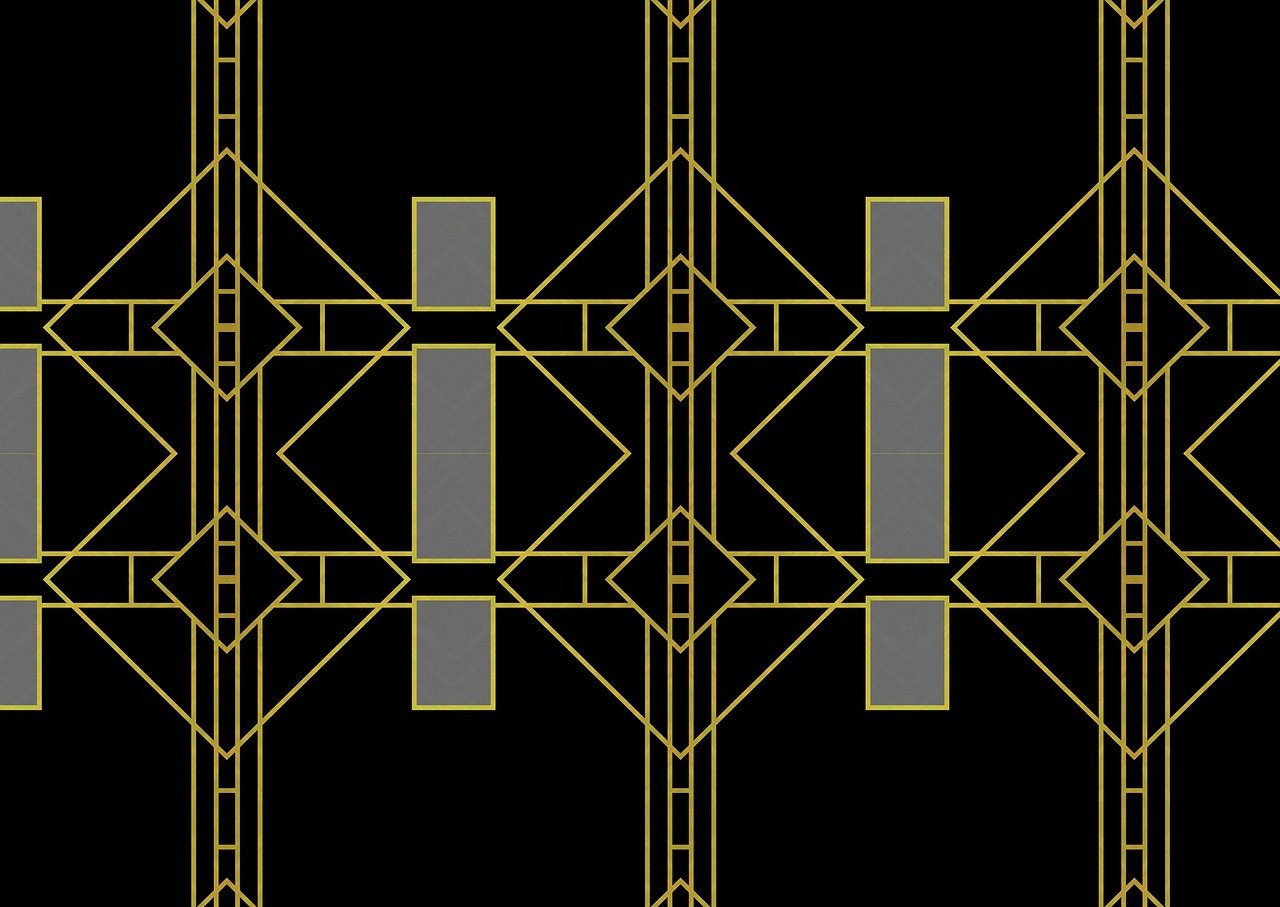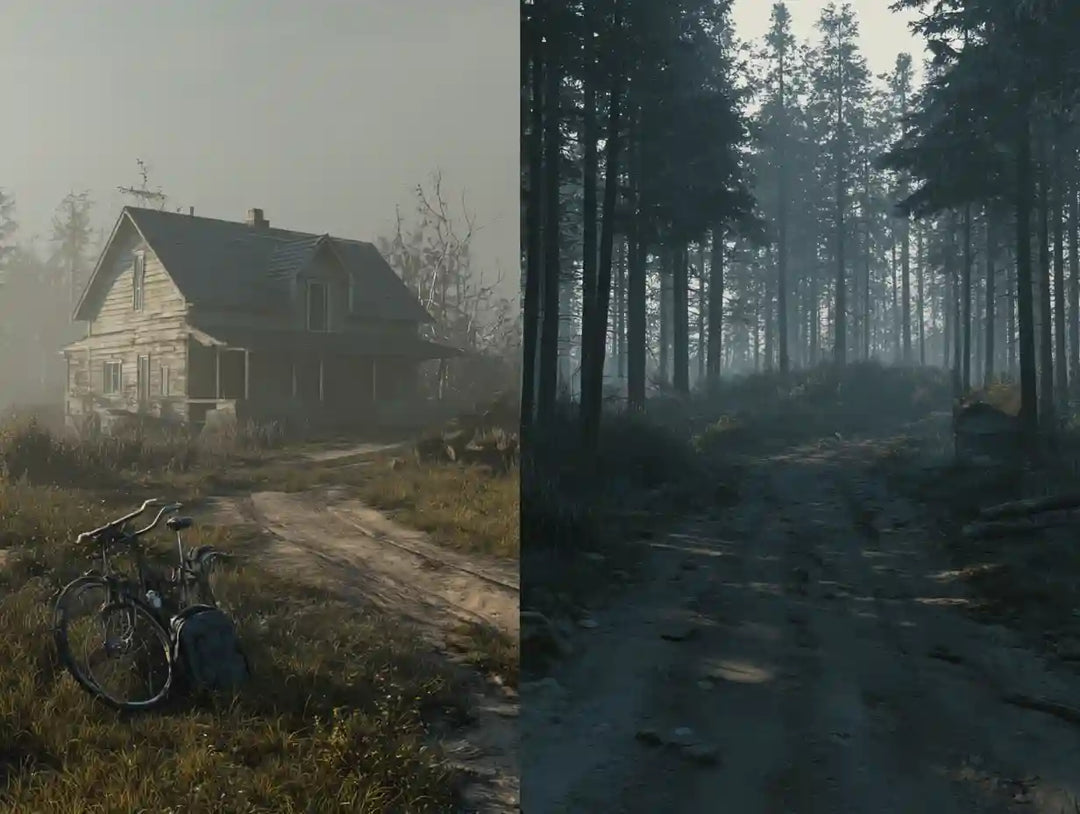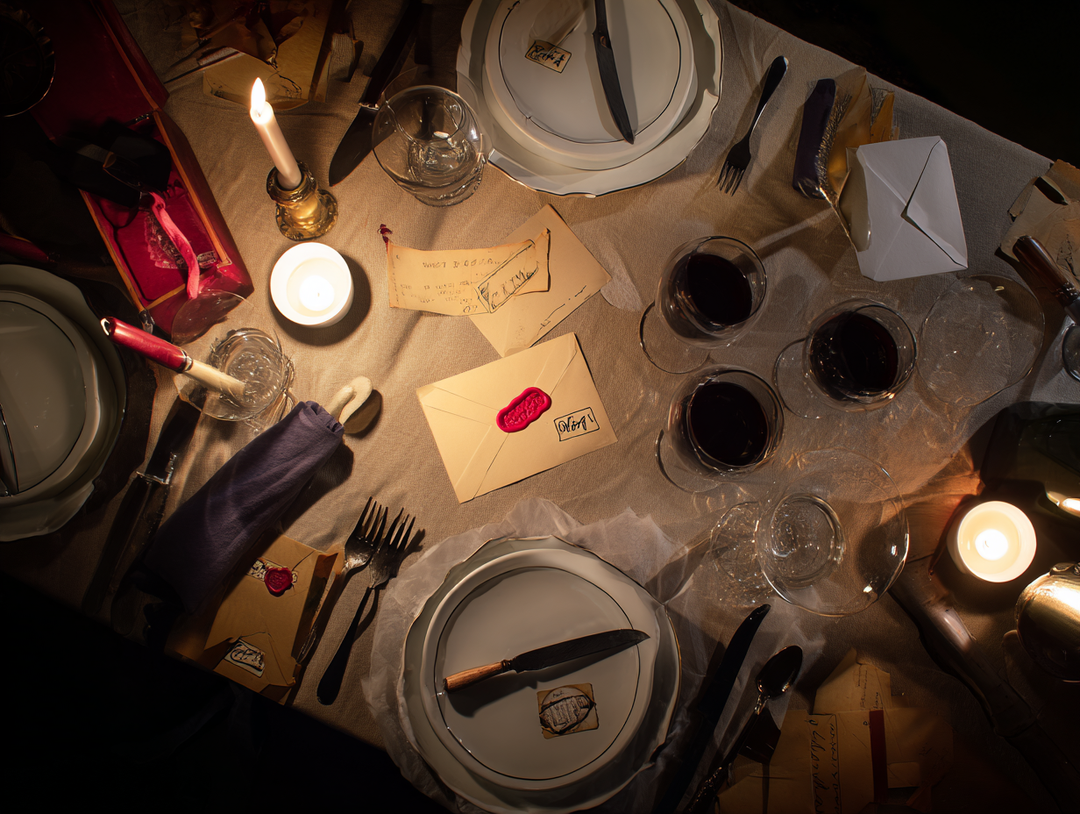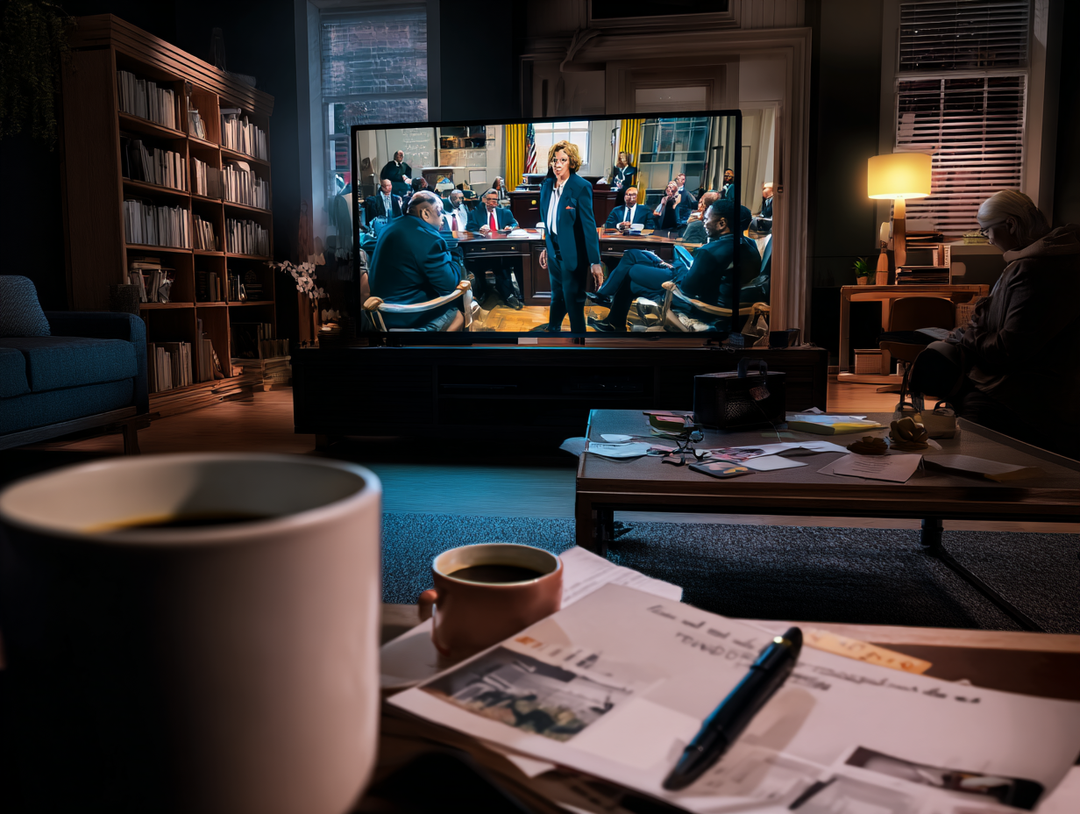The Art Deco era, spanning from the 1920s to the 1940s, was a time of glamour, sophistication, and rapid social change, this is why for many years it has been considered a perfect backdrop for murder mystery games, books and TV shows. This period, was known for its ritzy parties, speakeasies, and the stark contrasts between the glitz of the Jazz Age and the looming tensions of a world on the brink of war. Murder mysteries set during this era provide an opportunity to dress up and play a role, whether you’re stepping into the shoes of a cunning detective, mobster or flapper, these stories offer a thrilling journey into a world of secrets, it’s no wonder that it’s such a recognisable design aesthetic. In this blog we’ll be looking specifically at this Art Deco style and how it can influence a modern audience.
The Art Deco movement, flourished from the 1920s to the 1940s, it represents a period of luxurious design, characterised by bold geometric patterns, opulent materials, and a sense of modernity that resonated with the cultural shifts of the time. Often associated with the glamour of the Jazz Age, Art Deco was a reaction against the ornate Art Nouveau style that preceded it, embracing instead a sleek, streamlined aesthetic that celebrated progress, technology, and of course the era known as the Roaring Twenties.

The Origins and Influences of Art Deco
Art Deco takes its name from the International Exhibition of Modern Decorative and Industrial Arts held in Paris in 1925. The movement drew inspiration from a wide range of sources, including the geometric forms of Cubism, Egyptian and Aztec art, and the bold colours and simplicity of Fauvism. The era’s fascination with machinery, and technology also played a significant role in shaping the Art Deco aesthetic.
This eclectic mix of influences resulted in a style that was at once modern and decorative. Buildings, furniture, and decorative objects from the period often feature clean lines, sharp angles, and stylised forms that convey a sense of motion and energy. Materials such as chrome, glass and steel were commonly used, highlighting the period's industrial influences.
Key Characteristics of Art Deco Design
- Geometric Patterns and Symmetry: Art Deco design is often associated with strong, geometric patterns, such as zigzags and sunbursts. These motifs were used in everything from architecture and furniture to textiles and jewellery. Symmetry and repetition were also important elements, creating a sense of order and balance in design.
- Opulent Materials: Art Deco was a celebration of luxury, and this was reflected in the choice of materials. Rich woods like ebony and mahogany, exotic animal skins, ivory, and pearl were commonly used. Metals such as chrome and brass were also popular, adding a glamorous, reflective quality to the design.
- Bold Colours: The colour palette of Art Deco was both bold and varied. While black, white, and metallics were staples, vibrant colours such as deep reds, blues, yellows, and greens were also prominent. The combination of these colours with the luxurious materials created striking visual contrasts that were characteristic of the style.
Reviving Art Deco in the Modern Home
Bringing Art Deco into the 21st century can be a wonderful way to add a touch of glamour and sophistication to your home. Whether you're looking to make a bold statement or subtly bring elements of this iconic style into your life.
Incorporating Mirrored Furniture
One popular staple of Art Deco design was the use of mirrored furniture, which reflects the aesthetic of the period. In a modern home, mirrored coffee tables, dressers, or cupboards can be used to add a touch of vintage elegance.
When selecting mirrored furniture, look for pieces with geometric shapes or decorative inlays that echo the patterns commonly found in Art Deco design. Pairing these with rich, velvety textiles such as cushions and throws can create a luxurious, layered look was popular at the time.
Metallic Finishes
Metallic finishes are another key feature of Art Deco design that can easily be incorporated into a contemporary space. Brass, gold, chrome, and silver can be introduced through lighting fixtures, picture frames, or even smaller decorative items like vases and trays. A statement chandelier with a brass or chrome finish can serve as a focal point in a living or dining room, capturing the glamour of the Jazz Age.
For a more subtle approach, consider using metallic wallpaper with geometric patterns in a hallway or on a feature wall. This adds an element of Art Deco flair without overwhelming the space. Metallics also work well with dark colour schemes, such as emerald green or navy blue, which were popular in the Art Deco period.
Adding Bold Colours
Bold, contrasting colours were a signature of Art Deco interiors, and incorporating these into your modern home can be striking. Consider painting a single wall in a bold colour like teal, sapphire, or burgundy in an otherwise neutral room and include shelves or tables with accessories in gold, black, or white.
Another way to introduce bold colours is by adding cushions, rugs, or curtains, adding a pop of colour, while framed prints featuring geometric or stylised designs can bring a touch of the Art Deco sophistication to your walls.
Art Deco Furniture and Decor: Key Pieces to Look For
Whether you're on the hunt for authentic vintage pieces or high-quality reproductions, there are certain key items that will give you the Art Deco vibe in your home.
Authentic Art Deco Furniture
When searching for authentic Art Deco furniture, look for pieces that feature the defining characteristics of the style, such as clean lines, geometric patterns, and luxurious materials. Popular items include coffee tables, and armchairs with inlaid wood or lacquered finishes. Upholstered pieces with rich, textured fabrics like velvet or leather are also typical of the period.
In addition to this, materials like chrome and glass were frequently used in Art Deco furniture. For example, a glass-topped dining table with a chrome base can be an elegant addition to a contemporary space.

Lighting and Accessories
Lighting played a crucial role in Art Deco interiors, with chandeliers and table lamps often serving as both functional and decorative. Look for lights with stylised forms, geometric shapes, and metallic finishes. Frosted glass lampshades, etched with geometric patterns, were also common during the period and can add an authentic touch to your decor.
Accessories are another way to introduce Art Deco into your home. Items like mirrors or decorative screens with geometric patterns, and vases with stylised motifs can add character to a room. Don't be afraid to mix and match different materials and textures, as this eclectic approach was also characteristic of the Art Deco style.
Reproduction Art Deco Pieces
If authentic vintage pieces are out of your price range, then, there are many high-quality reproductions available. Browse thrift stores or home stores and you will often find pieces that reflect the style. When selecting pieces, focus on quality craftsmanship and materials that give you that feel of the original designs. This might include using wood veneers, metals, and textiles that mimic the richness of the period and bring a touch of glamour to your home without the need to source expensive antiques.
The 1930s continued to embrace the Art Deco style of the 1920s, but with subtle shifts that reflected the changing social and economic landscape. While the 1920s were marked by the exuberance and optimism of the Jazz Age, the 1930s were shaped by the Great Depression, which brought about a more subdued version of Art Deco. The glitzy flamboyance of the Roaring Twenties gave way to a more restrained elegance, but the core elements of geometric patterns, luxurious materials, and bold design still remained.
A Social Shift
In the 1930s, the Art Deco style evolved to include more streamlined styles, often referred to as "Streamline Moderne." This Art Deco sub-style featured smoother, curved lines, and a greater emphasis on function. The luxurious materials of the 1920s, like exotic woods and lavish textiles, were still present in some places but as times got harder and people started to struggle, society adapted to more affordable items. The colour palette also shifted, with the vibrant hues of the 1920s giving way to more muted tones, such as soft pastels and monochrome. Despite these changes, the essence of Art Deco's celebration of modern glamour, and artistic innovation persisted.
The 1930s were a decade marked by the global impact of the Great Depression, which led to widespread economic hardship and unemployment. This period also saw the rise of totalitarian regimes in Germany, Italy, and what was then known as the Soviet Union (Russia), contributing to the tensions that would eventually lead to World War II. Despite the economic challenges, the decade was also a time of significant cultural and technological advancement. Key developments included radios and telephones appearing in most homes as well as significant progress in medicine with the discovery of penicillin by Alexander Fleming, and early computing technology began to take shape through the work of scientists like Alan Turing. These innovations laid the groundwork for many modern technologies and had a lasting impact on society. In addition to these advancements, we also began to see the development of our Golden Age of Hollywood and the rise of swing music which had a profound influence on the Art Deco style. Hollywood films, with their lavish sets and dramatic plots as well as elegant costumes, showcased the aesthetic of Art Deco. Meanwhile, the energetic rhythms of swing music echoed the style and inspired lively, sophisticated social spaces like jazz clubs and dance halls and helped cement Art Deco as the epitome of stylish, modern design, blending entertainment, fashion, and architecture into the era.
DIY Art Deco Projects: Create Your Own Art Deco-Inspired Designs
For those with a creative streak, there are plenty of DIY projects that allow you to bring a touch of Art Deco into your home in a personalised and budget-friendly way. From creating your own sunburst mirror to designing patterned wallpaper, these projects can help you achieve an Art Deco look without breaking the bank.
DIY Sunburst Mirror
The sunburst motif is one of the most recognisable symbols of Art Deco design, and creating your own sunburst mirror is a relatively simple project that can add a stunning focal point to any room.
Materials Needed:
- A round mirror (size depends on your preference)
- Wooden dowels or metal rods
- Gold spray paint
- Strong adhesive or a glue gun
- Picture hanging hardware
Instructions:
- Start by laying out your wooden dowels or metal rods in a sunburst pattern around the mirror, adjusting the lengths and angles to create a balanced design.
- Once you're happy with the layout, cover the glass and then spray paint the dowels or rods gold, and allow them to dry completely.
- Attach the dowels or rods to the back of the mirror using strong adhesive or a glue gun, working carefully to ensure that they are securely attached.
- Attach the picture hanging hardware to the back of the mirror and hang it on your wall as a striking piece of Art Deco-inspired decor.
DIY Patterned Wallpaper
Creating your own patterned wallpaper is another way to introduce Art Deco style into your home. This project can be as simple or as complex as you like, depending on the level of detail you want to achieve.
Materials Needed:
- Plain wallpaper or a large roll of blank paper
- Stencils with geometric Art Deco patterns
- Paint in bold colours (e.g., black, gold, navy)
- Paintbrushes or sponges
Instructions:
- Choose a geometric pattern that fits with the Art Deco style, such as zigzags or stylised fans. If you're comfortable with freehand painting, you can create your own design; otherwise, use stencils to achieve a precise look.
- Lay out your wallpaper or paper on a flat surface and begin applying the pattern using your chosen paint colours. Work carefully, ensuring that the pattern is consistent and that the colours are bold and even.
- Once the paint is dry, you can hang the wallpaper as you would with any other paper. For an even simpler approach, you can create patterned panels to hang as wall art, which can be a great way to add Art Deco flair without committing to a full wall treatment.
DIY Decorative Screens
Decorative screens were a common feature in Art Deco interiors, often used to create a sense of division within a room. Creating your own screen allows you to customise the design and materials to suit your space.
Materials Needed:
- Folding screen panels (these can be purchased unfinished from craft or furniture stores)
- Decorative fabric or wallpaper with an Art Deco pattern
- Paint (optional)
- Staple gun or strong adhesive
- Decorative trim (optional)
Instructions:
- If desired, start by painting the screen panels in a colour that complements your chosen fabric or wallpaper. Allow the paint to dry completely.
- Cut the fabric or wallpaper to fit each panel of the screen, leaving a small border around the edges.
- Attach the fabric or wallpaper to the panels using a staple gun or strong adhesive, ensuring that it is smooth and free of wrinkles.
- If you want to add an extra touch of elegance, you can apply decorative trim around the edges of each panel using adhesive.
- Once the screen is complete, use it to create a stylish room divider or a decorative backdrop that adds an element of Art Deco sophistication to your space.
Conclusion: Bringing Art Deco into the Modern Home
Reviving the Art Deco style in a modern home offers a unique opportunity to blend the past with the present, creating a space that is both glamorous and timeless. The Art Deco era, with its emphasis on luxury and innovation, provides a rich source of inspiration for the modern home. Whether you're going with bold geometric patterns or fancy materials there are many ways to bring these elements into your home.
Investing in Art Deco furniture, such as mirrored tables, chrome lamps, or velvet sofas, can instantly elevate a room. Accessories such as sunburst mirrors, geometric rugs, and metallic art deco prints can also add a distinctive touch that nods to the era without overwhelming the space. Additionally, undertaking DIY projects and creating your own Art Deco-inspired wallpaper or refurbishing old furniture with bold, metallic finishes allows you to bring your own personal style into a room without breaking the bank.
Incorporating these elements can transform a space into a beautiful reflection of Art Deco's elegance and sophistication while maintaining a modern look where the timeless glamour of the Art Deco era meets the practicality and style of modern living. So why not have a go at styling your home in this popular style? As part of the grand unveiling why not host a murder mystery party to fully embrace the era? Check out our games at Masters of Mystery to find something that works for you!








